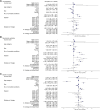Predictors of Severity of Influenza-Related Hospitalizations: Results From the Global Influenza Hospital Surveillance Network (GIHSN)
- PMID: 37527470
- PMCID: PMC11011157
- DOI: 10.1093/infdis/jiad303
Predictors of Severity of Influenza-Related Hospitalizations: Results From the Global Influenza Hospital Surveillance Network (GIHSN)
Abstract
Background: The Global Influenza Hospital Surveillance Network (GIHSN) has since 2012 provided patient-level data on severe influenza-like-illnesses from >100 participating clinical sites worldwide based on a core protocol and consistent case definitions.
Methods: We used multivariable logistic regression to assess the risk of intensive care unit admission, mechanical ventilation, and in-hospital death among hospitalized patients with influenza and explored the role of patient-level covariates and country income level.
Results: The data set included 73 121 patients hospitalized with respiratory illness in 22 countries, including 15 660 with laboratory-confirmed influenza. After adjusting for patient-level covariates we found a 7-fold increase in the risk of influenza-related intensive care unit admission in lower middle-income countries (LMICs), compared with high-income countries (P = .01). The risk of mechanical ventilation and in-hospital death also increased by 4-fold in LMICs, though these differences were not statistically significant. We also find that influenza mortality increased significantly with older age and number of comorbid conditions. Across all severity outcomes studied and after controlling for patient characteristics, infection with influenza A/H1N1pdm09 was more severe than with A/H3N2.
Conclusions: Our study provides new information on influenza severity in underresourced populations, particularly those in LMICs.
Keywords: disease severity; global health; influenza epidemiology; lower middle-income countries; surveillance.
© The Author(s) 2023. Published by Oxford University Press on behalf of Infectious Diseases Society of America. All rights reserved. For permissions, please e-mail: journals.permissions@oup.com.
Conflict of interest statement
Potential conflicts of interest . All authors: No reported conflicts. All authors have submitted the ICMJE Form for Disclosure of Potential Conflicts of Interest. Conflicts that the editors consider relevant to the content of the manuscript have been disclosed.
Figures





References
-
- World Health Organization. Influenza (seasonal). https://www.who.int/news-room/fact-sheets/detail/influenza-(seasonal). Accessed 13 June 2022.
-
- Neuzil KM, Wright PF, Jr ME, Griffin MR. The burden of influenza illness in children with asthma and other chronic medical conditions. J Pediatr 2000; 137:856–64. - PubMed
Publication types
MeSH terms
Grants and funding
LinkOut - more resources
Full Text Sources
Medical

